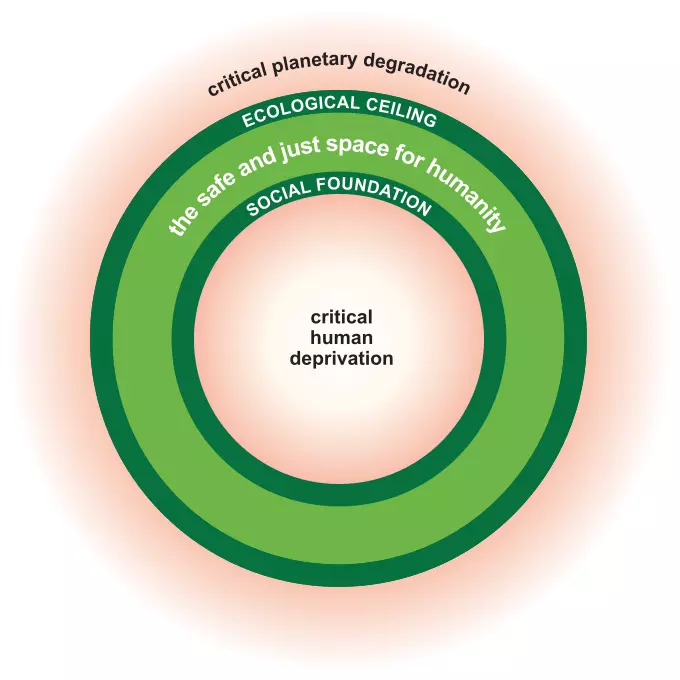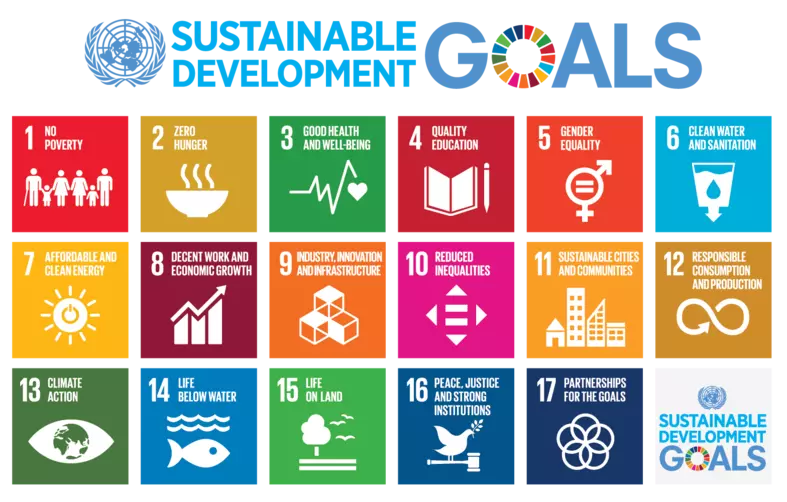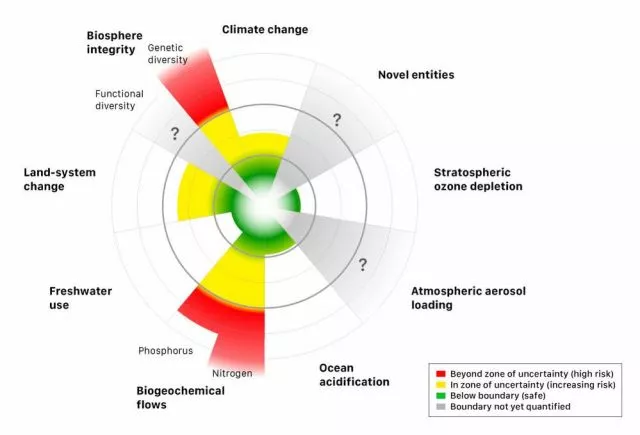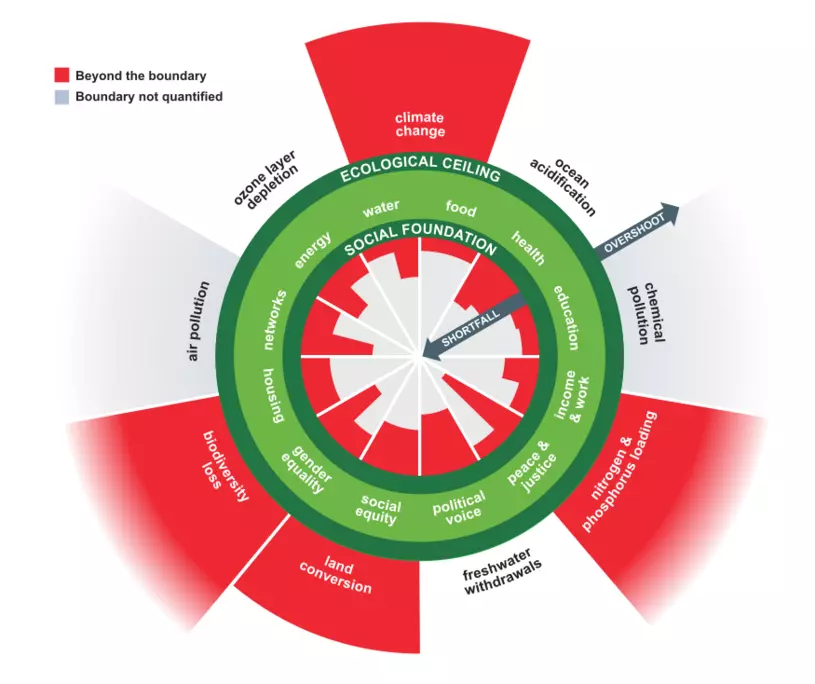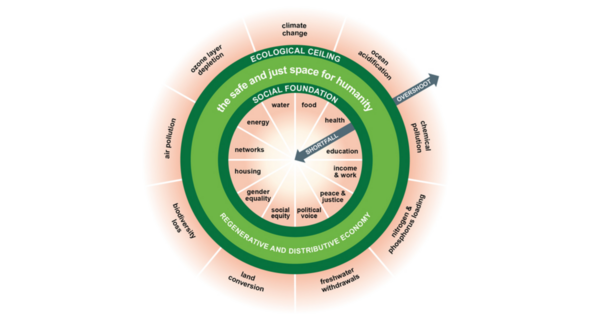
What is the Doughnut?
An introduction to the concept at the heart of Doughnut Economics

Version 1.0 (September 2020)
Overview
This tool is an introduction to the concept at the heart of Doughnut Economics. It's been designed as both a document that can be shared and a presentation that can be given in a classroom, a workshop or a meeting. Either download it as a pdf (below), open it within Google drive (links below) or scroll down to read on this page.
Links
Open as a document in Google Docs
Open as a presentation in Google Slides
What is the Doughnut?
Think of it as a compass for human prosperity in the 21st century, whose goal is to meet the needs of all people within the means of the planet.
It consists of two concentric rings:
- A social foundation – to ensure that no one is left falling short on life’s essentials.
- An ecological ceiling – to ensure that humanity does not collectively overshoot planetary boundaries.
Between these two boundaries lies a doughnut-shaped space that is both ecologically safe and socially just – a space in which humanity can thrive.
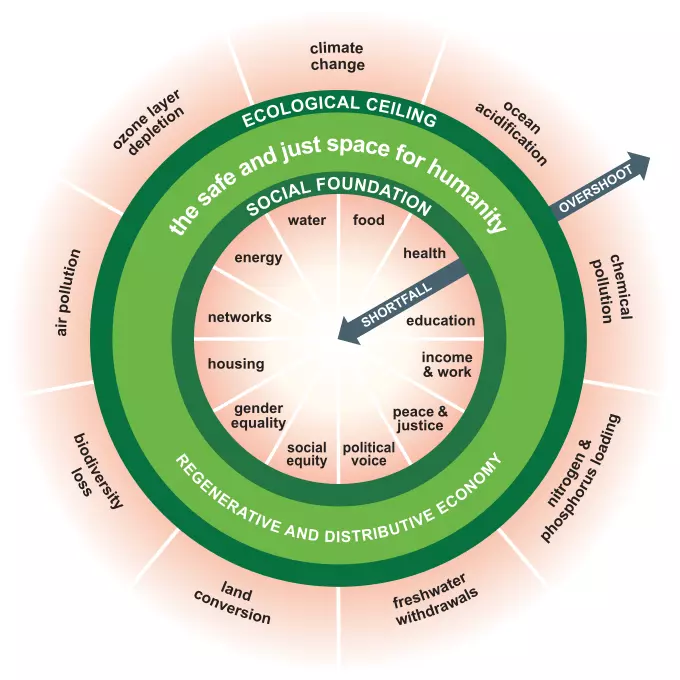
The essence of the Doughnut
1. The social foundation – below which lies critical human deprivation
2. The ecological ceiling – beyond which lies critical planetary degradation
These two boundaries are foundational in the sense that humanity should always seek to avoid critical human deprivation and critical planetary degradation. But how best to define their specific dimensions and measure their current status relative to desired outcomes will keep evolving over time.
The Doughnut’s dimensions
(as of 2017)
The Social Foundation
The 12 dimensions of the social foundation are derived from the social priorities agreed in the Sustainable Development Goals (UN, 2015).
The Ecological Ceiling
The 9 dimensions of the ecological ceiling are the nine planetary boundaries defined by Earth-system scientists (Steffen et al., 2015).
Quantifying the Doughnut
The image below reveals the current state of humanity and our planetary home: think of it as humanity’s ‘selfie’ in the early days of the 21st century.
Each dimension is measured, where possible, with 1 or 2 indicators, and the red wedges show the extent of shortfall and overshoot of the Doughnut’s social and planetary boundaries.
It shows us that millions of people still fall short on all 12 of the social dimensions, and that humanity has already overshot at least four planetary boundaries (air pollution and chemical pollution are currently unquantified).
To achieve the 21st century goal of meeting the needs of all within the means of the living planet means eliminating all of the red from the Doughnut diagram, and this must be done from both sides at the same time.
Find out more
- Explore the dimensions of the social foundation and ecological ceiling
- Explore the selection of these dimensions, including their limitations
- Read chapter one of Doughnut Economics: Seven Ways to Think Like a 21st-Century Economist
Share
Attachments
Share
-
Story

Doughnut economics on brillder
Our latest online learning module on brillder introduces students to doughnut economics
-
Story
.jpg)
Donut Brasil bursts into life!
Connecting diverse communities of practice around the idea and principles of the Donut
-
Story

Between D.E. and Gender Inclusion in Nigeria
Blending Doughnut Economics with Gender Inclusion as a solution for many challenges in Nigeria.
-
Story

Exploring sustainability in digital tech
Can Doughnut Economics be used as a holistic way of exploring the digital tech sector’s impact on global sustainability?
-
Story

Doughnut-PESTLE Hydrogen Model (DPHM)
Analysing the hydrogen economy by applying a Doughnut-PESTLE Hydrogen Model
-
Story

BORO Doughnut: DE in Middlesbrough
Bottom up practical steps taken to form a community action group and alliances to Downscale DE in a town
-
Story
.png)
Yerevan embraces “Doughnut mindset”
Reprioritizing priorities; Yerevan embraces “Doughnut mindset” on its way to sustainable development
-
Story

Renegade Neighbourhood Economists Wanted
Exploring Doughnut Economics in the round as peers.
-
Member


Ward Stirrat
Vancouver, British Columbia, Canada
-
Member


Sabrina Rodriguez
Buenos Aires, Ciudad Autónoma de Buenos Aires, Argentina
-
Member


Carolina Tomaz
Brazil
I describe myself as a XXI century economist, who adopts systemic and transdisciplinary thinking, and understands the world as a complex socio-ecological system. My goal is to work with regenerative projects for the development of inclusive, intelligent, and sustainable cities and communities. I have been particularly interested in applying the Doughnut economy model for cities, business and organisations. I have experience with projects planning and management, structuration and implementation of new governance models, and group's facilitation collaborative methods to co-create more effective and sustainable solutions for social problems. I'm part of the Donut Brasil network, and together we are experiencing the tools and knowledge of the Doughnut Economics in many projects and in the Latin America and Brazil contexts.
-
Member

Cathy Little
Grey Highlands, Ontario, Canada
I'm a second-term Councillor with the Municipality of Grey Highlands, a geographically large, rural municipality with a population of 10 000+. My responsibilities include Community and Economic Development Liaison, Economic Development Advisory Committee Member and Conservation Authority Board Member. My personal experience and professional life led me to Doughnut Economics. I am excited to learn and share with my community.
-
Member


Willem Baartman
Cape Town, Western Cape, South Africa
-
Member


Markus Neubauer
Wien, Österreich
I am interested in how to introduce the doughnut into businesses so that our businesses help us to thrive within the doughnut. I am happy about all ideas and literature recommendations regarding this topic.
-
Member


Adolfo Chautón Pérez
Cáceres, Extremadura, España & Marvão, Alentejo, Portugal
I am Spanish, I have a degree in Geography, a Masters in Strategic Territorial Development and have been living betwenn Spain in Portugal, in the frontier since October 2019. Professionally, I have 20 years of experience, always as a freelancer, working in different areas related to the territory: planning, participation, dynamization... For the last 15 years I have been working as a facilitator in territorial innovation and socio-ecological entrepreneurship, both as a facilitator of processes, as a trainer and mentor of social innovation projects or as a writer of several strategic territorial planning projects based on social innovation, both at regional and national level in Spain and internationally. As an independent researcher, I have developed several projects in which the Doughnut Economics model is always one of the strategic components. + info I am currently coordinating the BoraBeirã project in which the "LojaPlaneta" initiative is integrated. [Banner_Embajadora.png] #EMBAJADORA_ADE https://www.alianzadonut.es/
-
Member


Guillaume Féry
Lausanne, Vaud, Switzerland
My expertise is in water, energy and natural resources management. I focus on SDGs 6, 7, 9 and 11. I am a Senior Digital Transformation leader focused on creating value through technology enabled change. Particularly using sustainability themes such as clean and smart technologies as a lens for new products & services. Motto: "Focusing is about saying no" - Steve Jobs.
